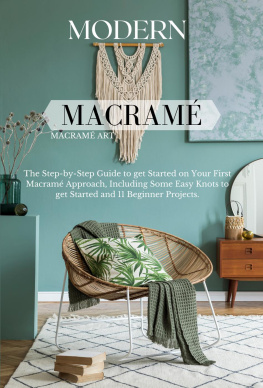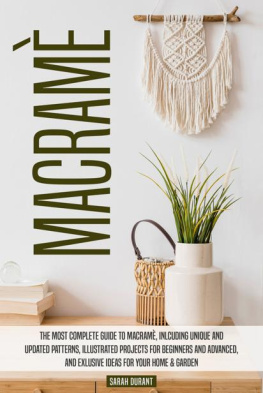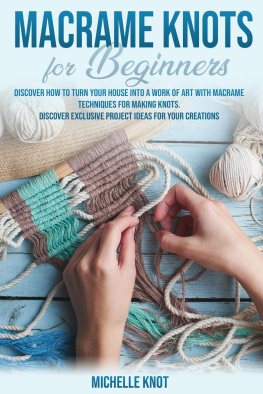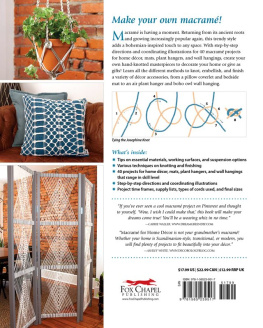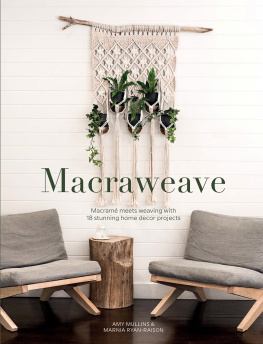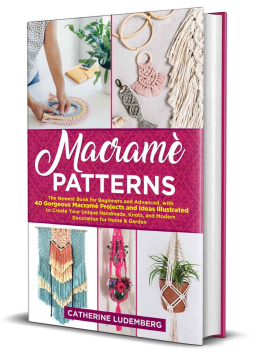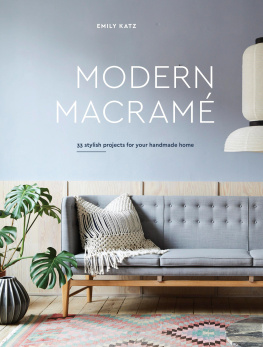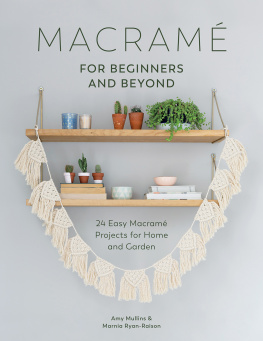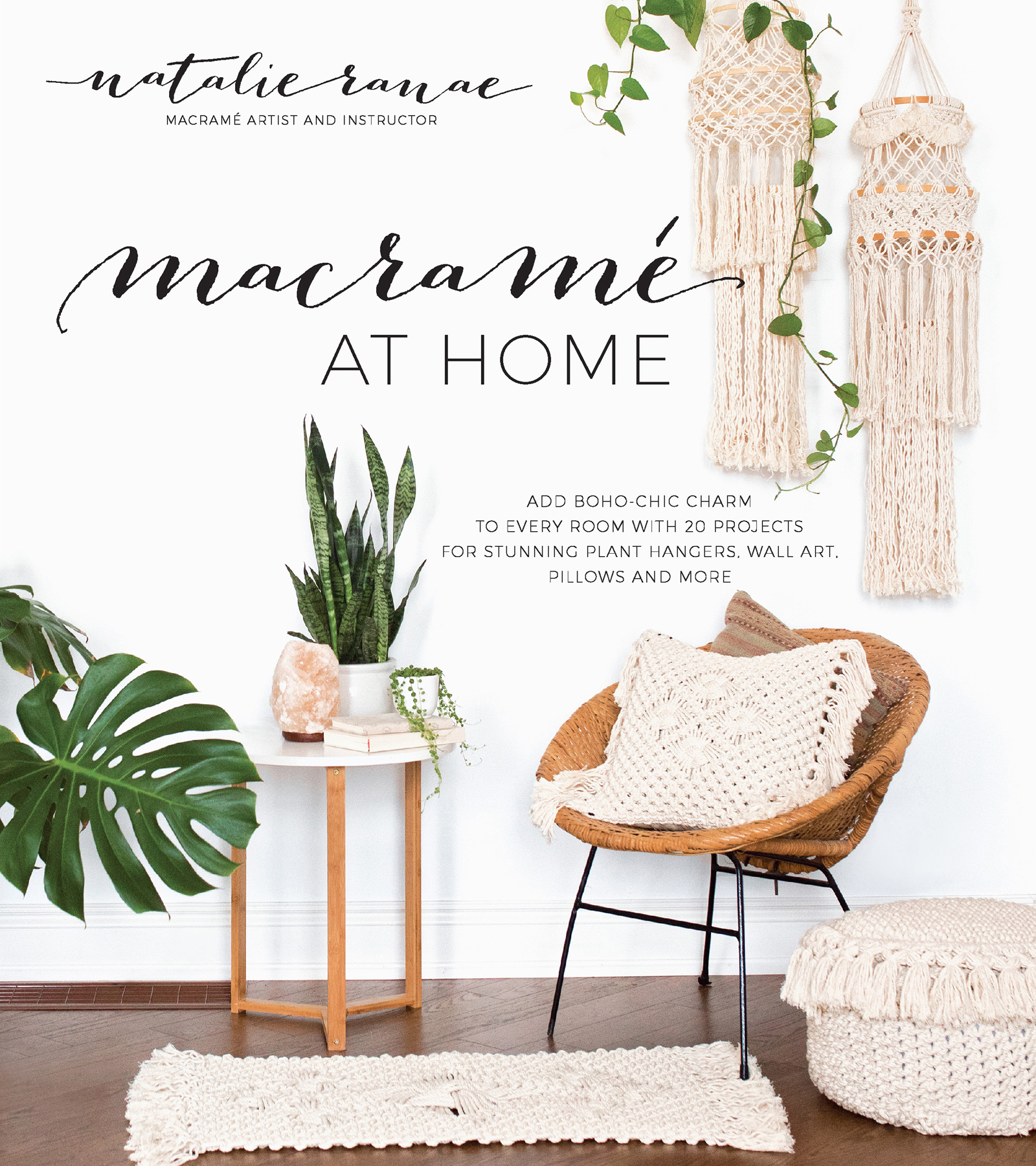ADD BOHO-CHIC CHARM TO EVERY ROOM WITH 20 PROJECTS FOR STUNNING PLANT HANGERS, WALL ART, PILLOWS AND MORE
The author and publisher have provided this e-book to you for your personal use only. You may not make this e-book publicly available in any way. Copyright infringement is against the law. If you believe the copy of this e-book you are reading infringes on the authors copyright, please notify the publisher at: http://us.macmillanusa.com/piracy.
To every creative and artistic soul seeking to learn more.
And to my incredible husband and best friend, Shawn.
Macram is back! Like most things in life, everything comes back around in style eventually, and macram is finally having its moment again. Except this time around its characterized by a new modern look, much less brown and orange jute, and fewer owl patterns that characterized the 1970s. Macram, which at its simplest is the art of creating patterns out of knots, has made a huge emergence into modern home decor, whether thats through artistic wall hangings, beautiful and practical plant hangers or by being worked into everyday objects, home accents or furniture. If youre looking to add some unique textural designs to your home while also learning a fun new craft, youve picked up the right book!
My first introduction to the world of macram was a trio of macram owls that my grandmother had hung up in the hallway in her cottage. One had a pair of large, red wood beads for eyes, and I remember my younger sister and me being so afraid of them that my mom had to hide them when we would visit! This book is evidence that a lot has changed since those days, as I am now completely obsessed with this wonderful art form. Im so happy and fortunate to spend my days designing new macram pieces, making large-scale custom orders and spreading the love of macram though workshops and tutorials.
I love macram because it offers the opportunity for endless creativity. The combination of knots and patterns allows you to take a piece in so many different directions. Ive been a maker my entire life, doing everything from knitting and crocheting at a young age to becoming a professional jeweler and metalsmith, and I can honestly say that macram is one of my favorite outlets for creativity. However, consider this fair warning that macram is extremely addicting! After learning even just a few of the knots and projects in this book, your brain will be filled with an endless amount of ideas, and before you know it your home will be filled with macram, like mine is!
Whether this is your first time encountering macram or youve had some experience with the medium, youll find projects in this book for you. I divided the projects into three categoriesbeginner, intermediate and advanced. If youre new to macram, Id advise you to hold off on attempting the advanced projects until youre able to work through some of the beginner and intermediate projects at a good pace. Each project has a unique variation that I designed to change the look of the design. All of the projects are organized into three chapters: Wall Hangings (). Feel free to start in whichever chapter youre most excited about and bounce around projects from there. Theres no right way to use this book, but my hope for you is that it will push you to continue to express yourself creatively, seek inspiration and challenge yourself!
Macram, like any craft, takes patience and attention to detail. However, its relatively easy to pick up, and highly addicting once you understand the basics!
You dont need any fancy tools or apparatus to make macram on; you simply need to be able to hang your project from something. You can get creative and string your piece from something like a curtain rod or hooks on the back of a door. I prefer to work on a clothing rack that rolls because I can move it around easily and its height is adjustable for when I start working lower on a piece. Using large S-hooks, I hang all my projects from the rack and its the perfect way to work. I like this setup because its more ergonomically suited for your body, which is important if youre spending a substantial amount of time on a project!
Besides rope, what youll need for each project is a good pair of scissors or shears, as they will make your life much easier. In all the projects, I work with 100 percent natural cotton cord. You can use either three-strand or braided cord for most projects, but I also list which I use in each project. Using three-strand or braided slightly changes the look and texture of each project, but they are largely interchangeable. Another helpful tip is to wrap a little bit of masking tape on the ends of your cords before you start. That helps prevent the cords from unraveling while youre working with them. Once a cord unravels you cant put it back together and you dont want it to interrupt where you are tying knots.
Each project will have a more in-depth look at tools needed, rope type and length requirements. Theres also a resource guide I put together for you at the back of the book () because macram supplies can sometimes be hard to find!
I hope youre excited to learn and ready to make some projects with me!
useful terms & phrases
Working Cords: When tying a knot, these are the cords you are handling and physically using to tie the knot. For example, the working cords are the two cords on the outside of four cords used to tie a square knot (see ).
Filler Cords: These are the cords that knots are being tied around. They are typically the cords in the middle of the knots. For example, the two filler cords are in the middle of a square knot (see ).
Tight to the row/knots before: This phrase refers to the space left between each row or knot and is indicating for you to leave no space. This means the knots row after row are tied with no space in between each knot and row.
Ending with a point or sharp point: This is normally indicating to end with one type of knot, usually a double half hitch. Learn how to tie it with a point .
Fringe: The frayed unraveled rope usually at the bottom of the piece.
Unravel: This refers to undoing a piece of rope. See my method for unraveling rope .
This section will teach you how to make all the knots and patterns used in this book. Be sure to tie your knots with the same strength and tightness to keep your pattern looking consistent. This will help make your work look neat. Remember, these are knots, so tie them firmly so that they dont come loose, especially in your last row before your fringe. Try practicing these knots before working on the projects if you feel it will help. Alternatively, before you start a certain project, take a look at the list of knots used and reference this section to practice beforehand.



